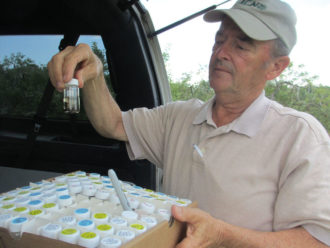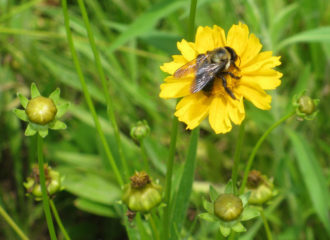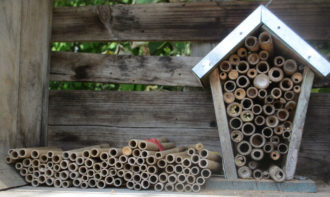McCAYSVILLE, Georgia – Joe Dickey’s curiosity about bees nearly matches his affinity for birds.
“I’ve loved birds ever since I was a kid because of all their different colors,” said Dickey, as he watches yellow finches fly around three 100X100-foot wildflower plots at his farm, Mountain View Orchards. But it’s the bees that are capturing his attention lately, and the wildflowers were planted for them.
“I didn’t start my apple orchard for bees,” said Dickey, who bought 20 acres near the Tennessee border in 1963 with money he made shining shoes on the street corner at 8 years old. “I just never realized how important the bees are and just how many different kinds there are. But what I know now, I want to keep them around.”
The wildflower plots adjacent to Dickey’s apple trees are part of a Southern SARE Producer Grant (FS16-290, "Measuring the Benefits of Wildflower Plots to Boost Fruit Yield and Pollinator Abundance in Georgia Apple Orchards") to measure the abundance and variety of native pollinators and whether the added food source for the bees leads to higher apple yields.
Bumblebees, mining bees, mason bees, carpenter bees, sweat bees – in the last year they’ve all visited Dickey’s wildflowers and subsequently pollinated his apple trees. The effects of the wildflower plots on his apple crop were immediate: In 2016, apple production surged 30 percent from the previous 2 years when the wildflowers were absent from his orchard.
“I’m just amazed by what we’ve found,” said Dickey. “I think that the added wildflowers not only helped to attract bees when the apple blossoms needed to be pollinated in the spring, but the flowers are still providing a food source so the bees are sticking around and finding a place to live.”
Indeed, on a warm June day, with the apple blossoms long gone, the bees are still coming around – feverishly working the sea of yellow flowers. Dickey has seen wild honeybee nests in the trees adjacent to his orchard and he’s created artificial bee houses for native pollinators – most notably the mason bee, a proficient pollinator, but a picky homeowner.
Dickey’s next step is to compare annual wildflowers to perennial wildflowers to see which type is best at recruiting native bees, also funded through a SSARE Producer Grant (FS17-296), "Which Wildflower is Best at the Recruitment of Native Bees into Agricultural Areas? A comparison of perennial vs. annual wildflowers."
Mountain View Orchards is one of four north Georgia orchards that are part of a larger Georgia Gwinnett College native pollinator effort to measure native bee pollinator abundance and diversity in apple orchards. The studies have been funded through Southern SARE On-Farm Research Grants.
Researchers have identified over 100 native bee species at Mountain View Orchards. Some are ultra-rare, less than three specimens ever found anywhere, said Georgia Gwinnett College biology professor Mark Schlueter.
At 72, Dickey has spent the better part of 50 years tending his orchard, and one thing he’s found is that if you nurture nature, nature is happy to give back.
Published by the Southern Region of the Sustainable Agriculture Research and Education (SARE) program. Funded by the USDA National Institute of Food and Agriculture (NIFA), Southern SARE operates under cooperative agreements with the University of Georgia, Fort Valley State University, and the Kerr Center for Sustainable Agriculture to offer competitive grants to advance sustainable agriculture in America's Southern region. This material is based upon work that is supported by the National Institute of Food and Agriculture, U.S. Department of Agriculture, through Southern Sustainable Agriculture Research and Education, under sub-award number: FS16-290. USDA is an equal opportunity employer and service provider. Any opinions, findings, conclusions, or recommendations expressed in this publication are those of the author(s) and do not necessarily reflect the view of the U.S. Department of Agriculture.



